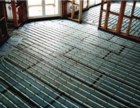Building for a low-energy future starts now

Chris Ingram, chairman of the Underfloor Heating Manufacturers’ Association believes that future-proof underfloor heating will become the standard low-carbon choice
Only one thing is certain about the future – it will be different. For years underfloor heating and radiators have been rivals for the heat-emitter crown. Now, with its target of an 80% reduction in carbon emissions, the UK is moving fast towards a ‘greener’ future — one where gas-fired boilers and radiators may soon have no place in new build projects.
Underfloor heating, especially when coupled with renewable energy sources, is finally recognised as delivering significant savings in energy and carbon-emissions compared to any other form of heat emitter.
And it’s renewables — solar power, biomass, heat pumps and perhaps technologies yet to come — that will provide the heat for the homes, offices and factories of the latter 21st Century.
The buildings we erect now must be ready for the change. Even if they are not served by renewable energy now, they must be capable of being adapted. And that means they must be equipped with high-efficiency, low-energy heat emitters from the outset.
Underfloor heating (UFH) is the only practical future proof choice.
More efficient
Renewable heat sources work best when they deliver the lowest possible water flow temperature to a heating system. Every degree increase in the temperature of the water supplied degrades the efficiency of the renewable heat source. For a typical ground-source heat pump that transfers solar energy collected by the ground to the heating system, a typical flow temperature of 35°C would ensure the unit provides a COP of 4.. Set the flow temperature to 45°C, however, and the COP drops dramatically to 2.5.
Using an underfloor heating system with an air- or ground-source heat pump means that the flow temperature can be in the range 35 to 40°C, and sometimes (subject to the building fabric and floor covering) as low as 30°C.
An alternative solution (often discussed, but seldom put into practice) is to fit oversized or low-surface-temperature (LST) radiators. Typically these need to be twice the size of a normal radiator and require a flow temperature of at least 45°C — often in excess of 50°C — with a corresponding significant reduction in the energy efficiency of the whole heating system.

Scientific research now confirms these facts.
An extensive study commenced in 2005 by the International Centre for Indoor Environment & Energy and EU-Ray showed that, when compared to using ‘low-temperature’ radiators, UFH is 30% more efficient when coupled to a ground-source heat pump and 20% more efficient with an air-source heat pump.
The same study demonstrated that when UFH is compared to LST radiators coupled to a condensing boiler, the saving is a more modest 5% — a figure that is still significant in terms of carbon-reduction where millions are spent to achieve every percentage point of gain. When compared to normal radiators with a condensing boiler the saving is 15%. The study also showed that the savings were reasonably consistent whether the property was a house, an office building or an industrial building, and the climatic zone did not significantly vary the percentage savings.
Professor Bjarne Olesen, author of the report and one of Europe’s pre-eminent independent experts in the field concluded, ‘In general floor heating comes out as the best system in all cases.’ (My italics)
No hot surfaces
Energy efficiency may the prime benefit of a future in which underfloor heating becomes the standard solution, but it is far from the only one. Low surface temperatures, for example, offer a significant advantage in hospitals, schools, care centres and other applications where comfort must be combined with care. Floor-heating systems with a maximum permitted floor surface temperature of 29°C (BS-EN1264) automatically solve the problem of hot surfaces as the safety factor is built in.
They also offer a substantial increase in useable floor area, complete design freedom and a huge reduction in annual maintenance, because there are few exposed fittings to be vandalised or broken.
Indeed the long life of UFH system components is a major contribution to future proofing. The pipework will typically have a minimum design life of 50 years, outlasting steel radiators by a long way, thus avoiding the need for replacement at regular intervals during the life of the building. Even if we are rich enough, or profligate enough, to ignore the cost factor involved in replacing radiators, the disruption caused is a big enough issue in its own right.
So, an underfloor heating system installed in the present will provide carbon saving comfort long, long into the future. Isn’t that what ‘green engineering’ is supposed to be about?








